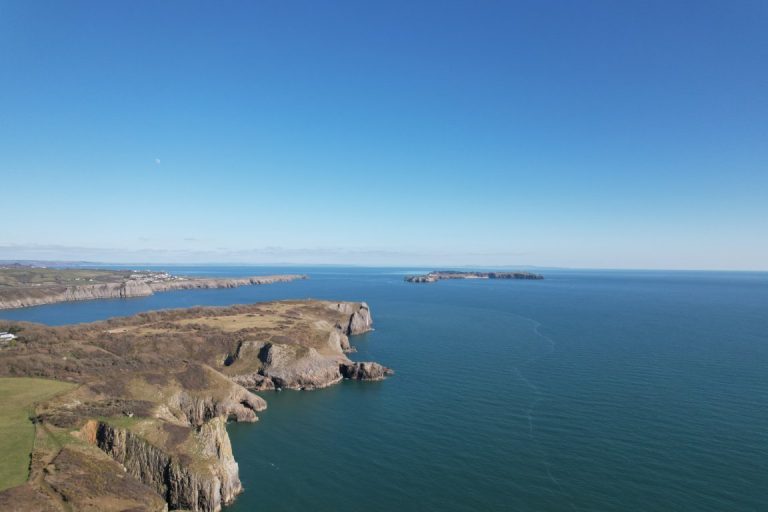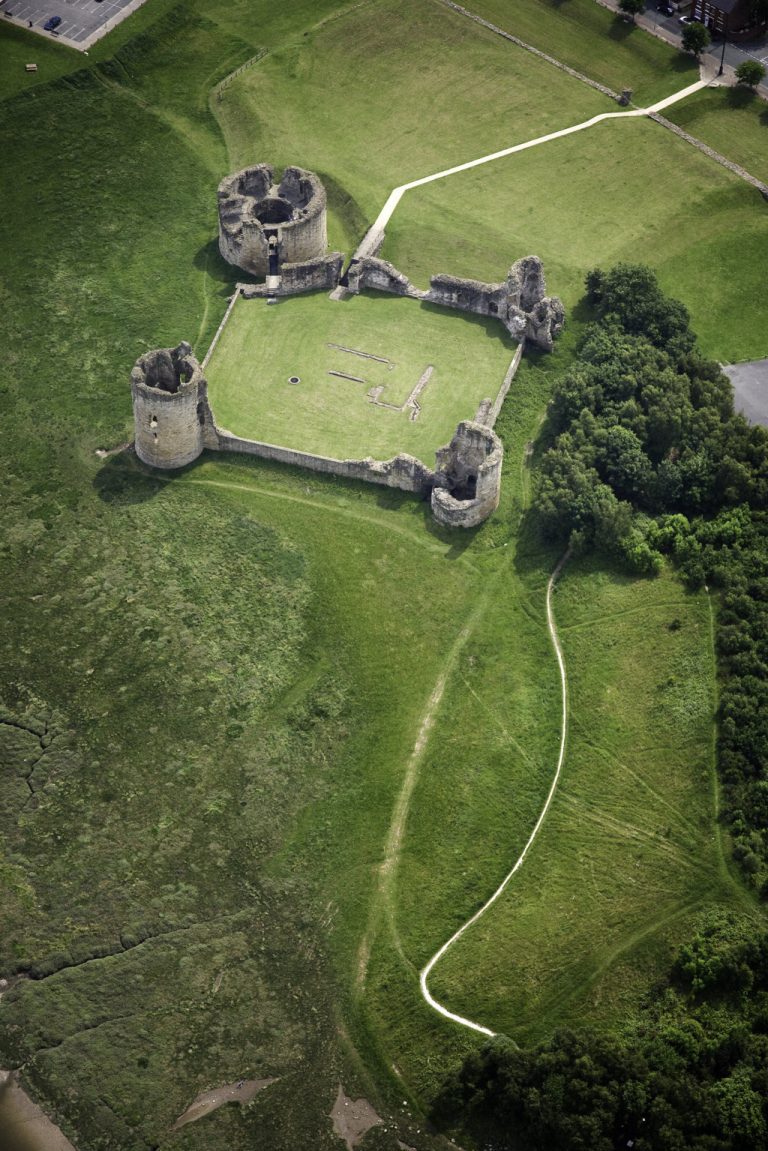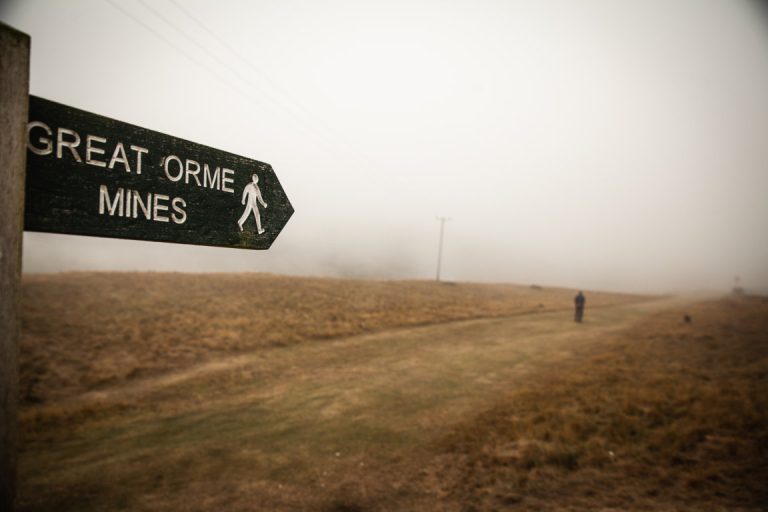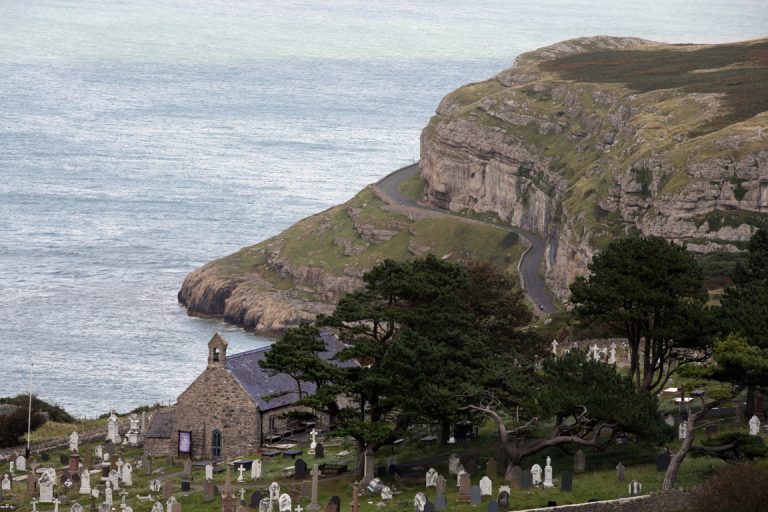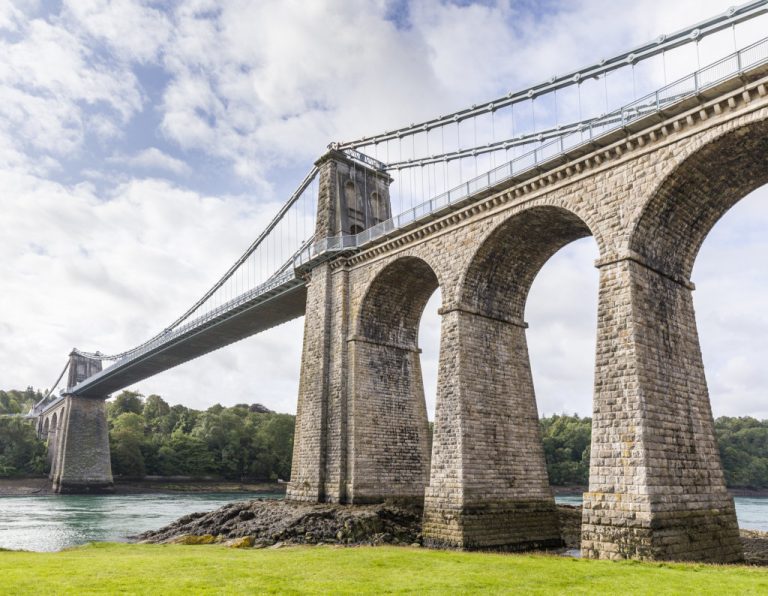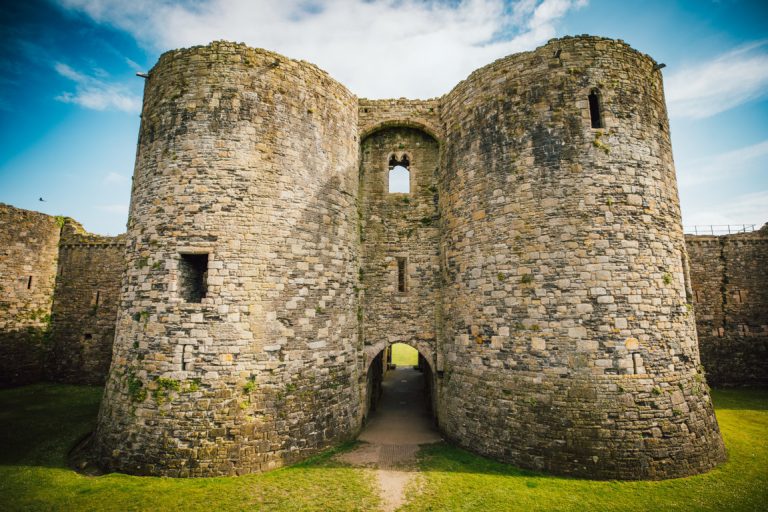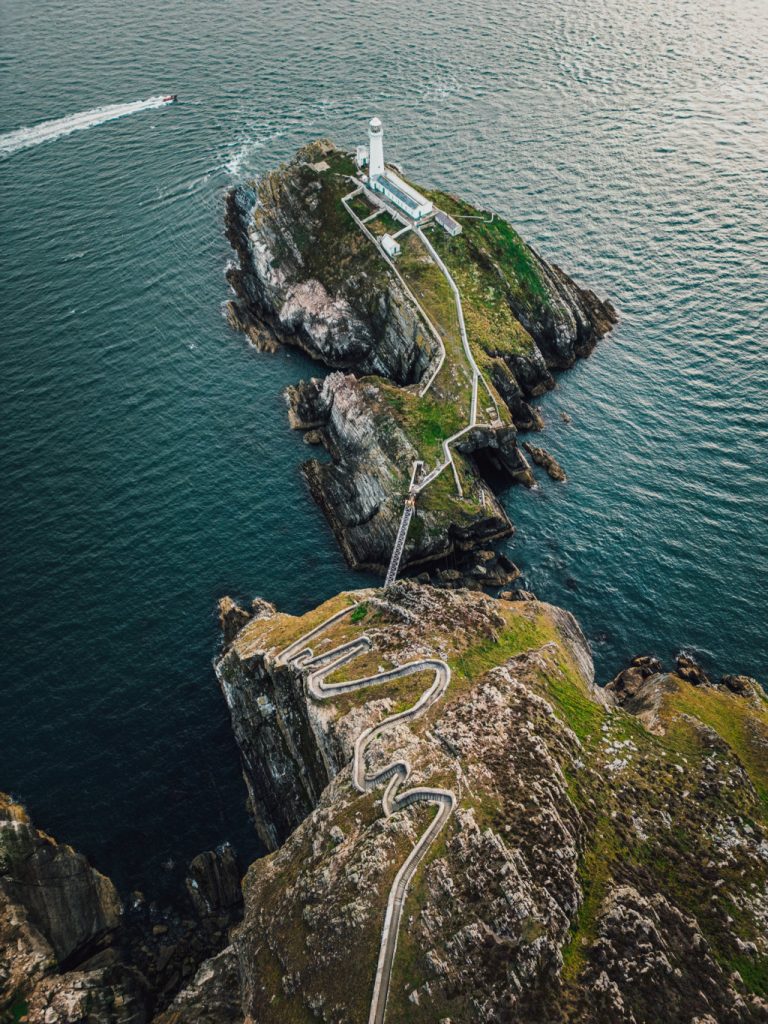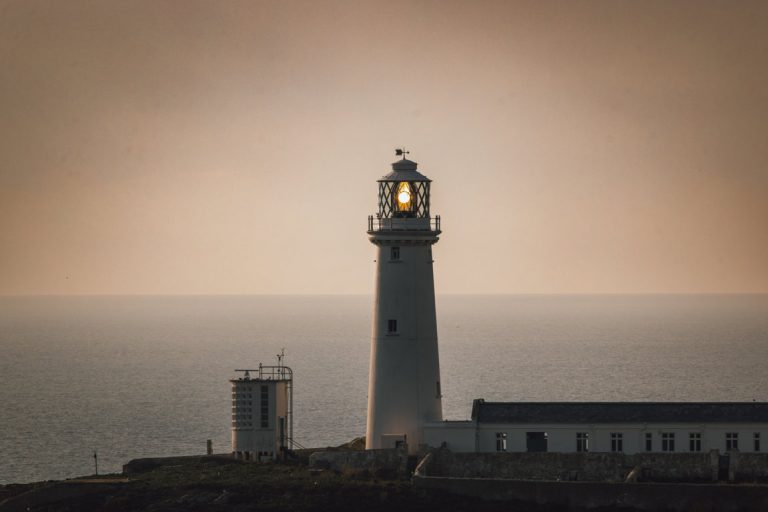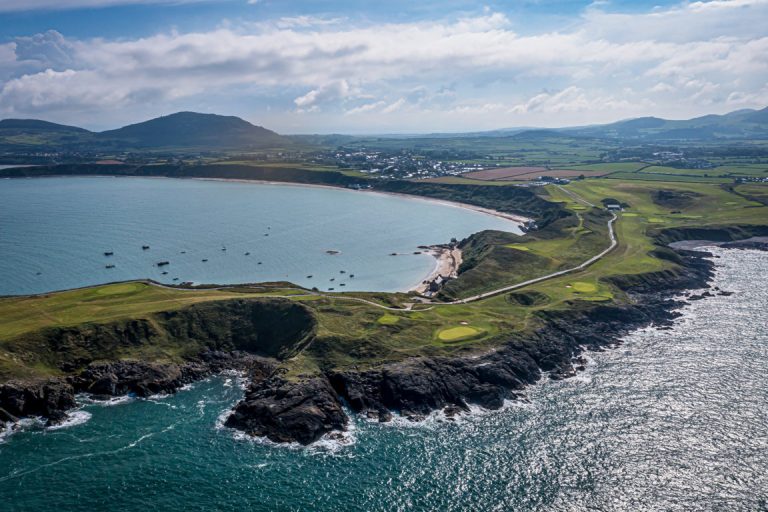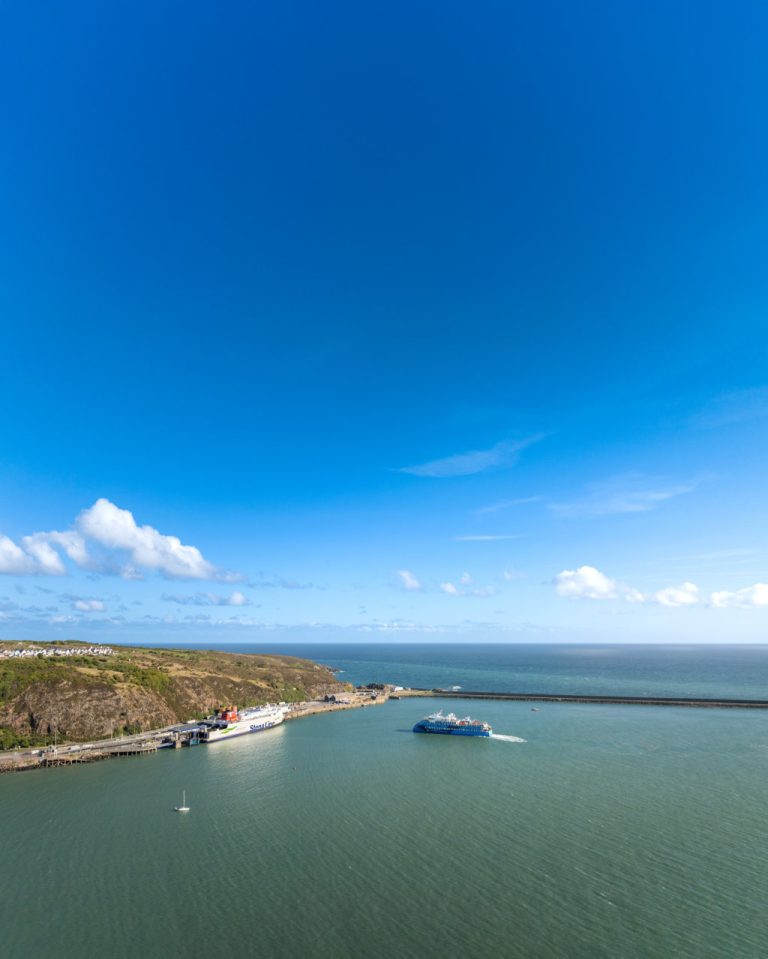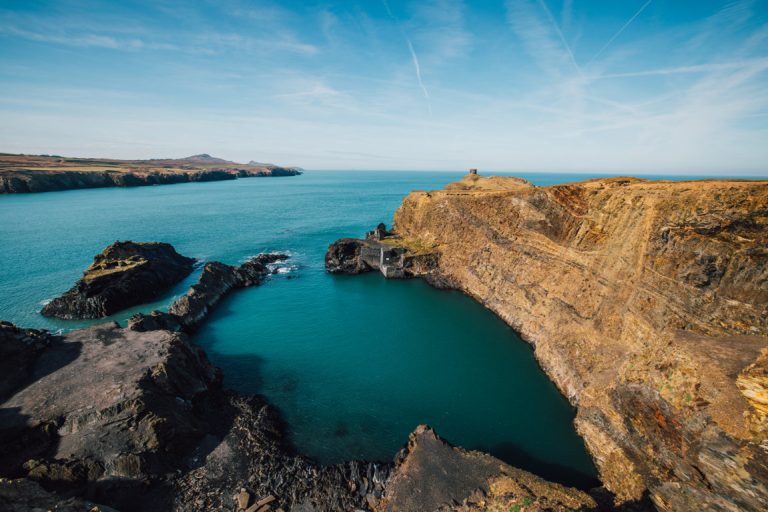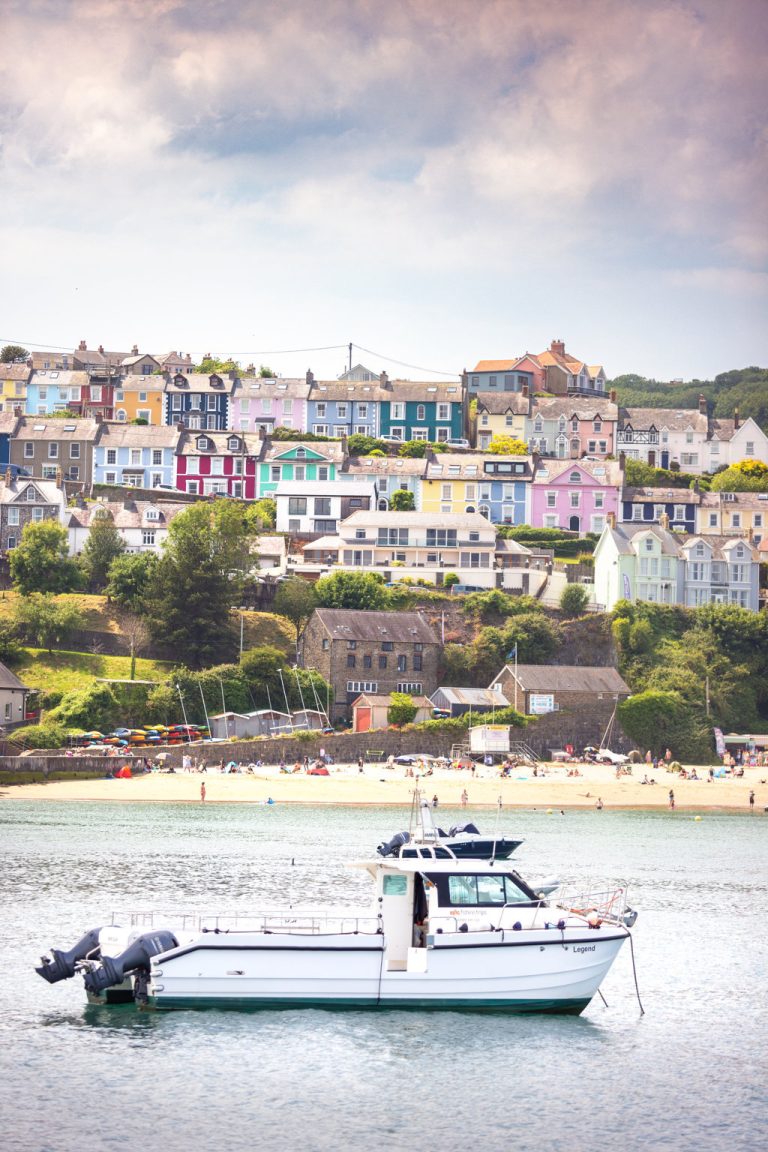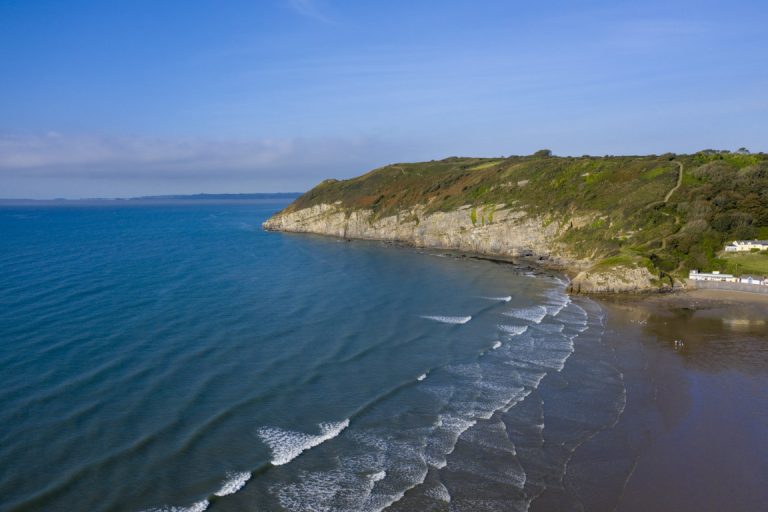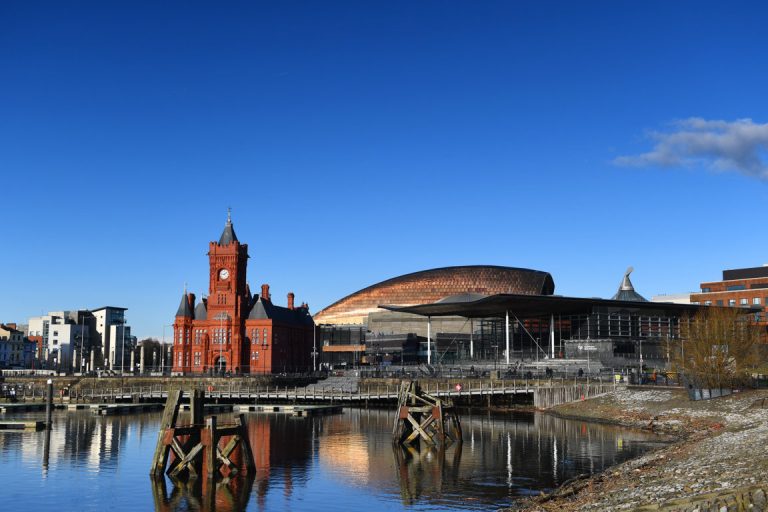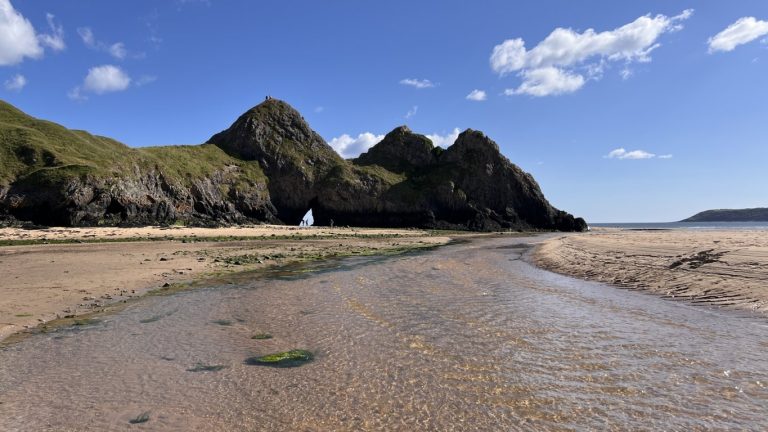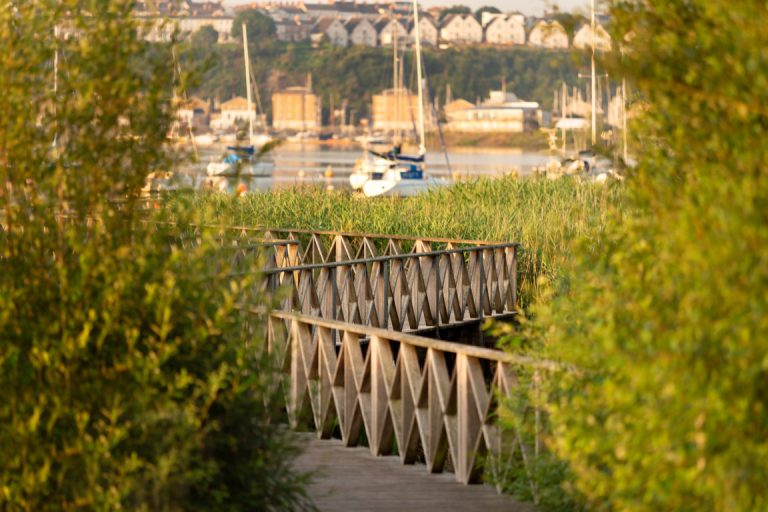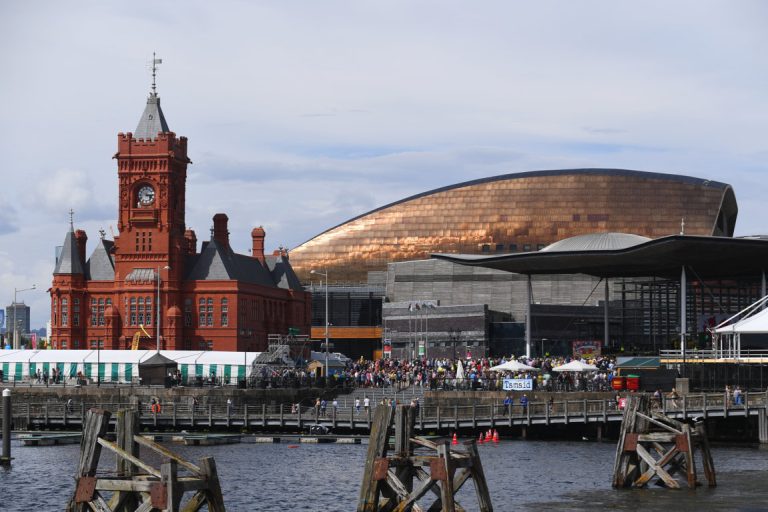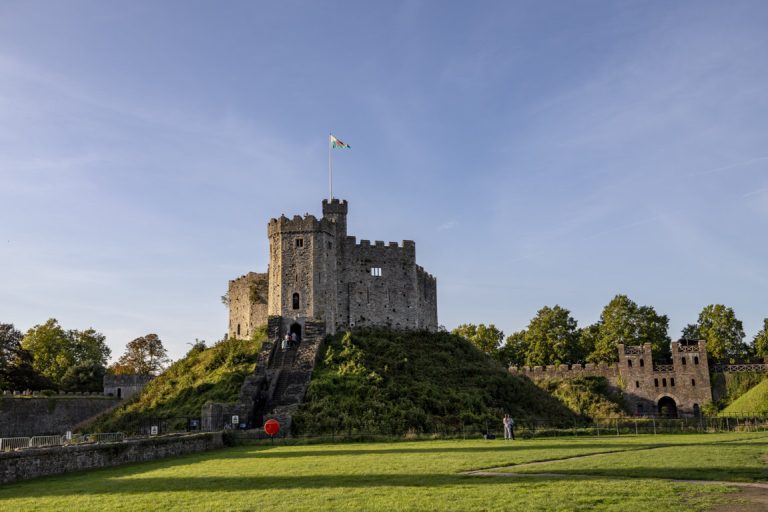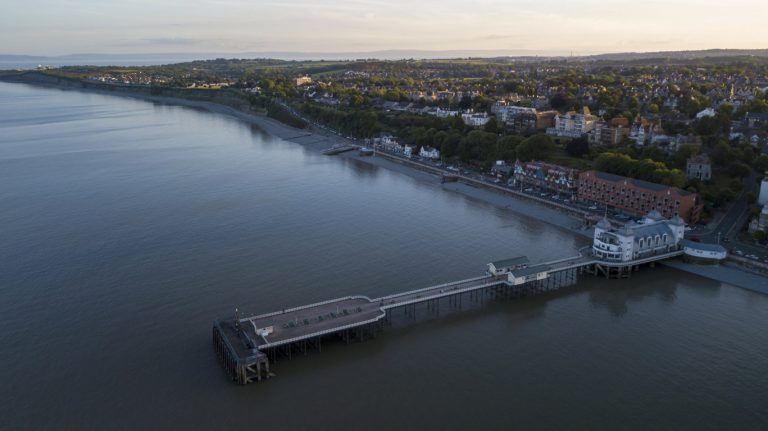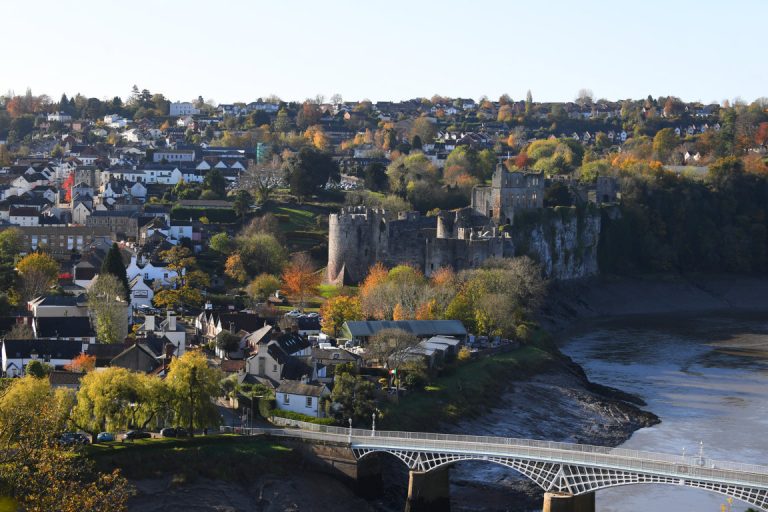Wales Coast Path: A Journey Through the Soul of Wales
Walking along the coast of Wales is not merely an outdoor activity; it is an immersion into a land that tells its story through the tides, cliffs, castles, and the words of its poets.
The Wales Coast Path, inaugurated in May 2012, is much more than a simple trail: it is a thread that stitches together the extraordinary natural and cultural diversity of Wales, becoming the world’s first continuous coastal path that follows the entire coastline of a nation, covering a total of 1,400 kilometers.
Pembrokeshire-coast-path
Before its opening, Wales already boasted beloved hiking routes such as the Pembrokeshire Coast Path, opened in 1970, and the Anglesey Coastal Path, completed in 2006. However, the idea of creating a continuous route around the entire marine perimeter of the country was revolutionary. This ambitious project united existing stretches and created new ones, offering today a unique opportunity to discover every nuance of Welsh territory: from the wild beauty of sea cliffs and moorlands to sandy, tranquil bays, from bustling port towns to villages where time seems to have stood still.
The Wales Coast Path is divided into eight main sections, each unique for its landscape, culture, and history. The northern coast of Wales is the ideal place to begin exploring what awaits along the path. Here, the landscape offers an introductory overview of the country’s myriad facets. The trail starts near the northeastern border, close to the town of Flint, and for 132 kilometers winds along the Dee River estuary and the windy beaches of the north coast. Shortly after the start, hikers encounter the imposing ruins of Flint Castle. This fortress, built by Edward I in the 13th century, has witnessed centuries of turbulent history, from Welsh uprisings to civil wars. Walking among its walls today means touching the ancient history of Wales, in a silence broken only by the sound of the waves and the wind.
Flint Castle
Great orme
st-tudnos-church-great-orme-llandudno
Further along, the coast leads to Llandudno, a seaside resort that still retains its Victorian elegance, where ships call at port by anchoring close to the shore, allowing easy and picturesque access to the landing area. The white façades of the seafront hotels, the long wooden pier, and the funicular railway that climbs to the Great Orme offer a nostalgic glimpse into late 19th-century tourism. But there is also a literary magic here: according to tradition, the real Alice Liddell, muse of Lewis Carroll, spent her summer holidays here, giving rise to the connection between Llandudno and the fairy tales of “Alice in Wonderland.” The path continues toward Bangor, considered the oldest city in Wales. Despite its modest size, Bangor houses a millennial cathedral and the Storiel museum, which collects objects, photographs, and artworks that tell the story of the region’s identity and evolution. Strolling through Bangor allows one to connect with the more intimate and everyday dimension of Welsh culture.
The entire northern section of the path unfolds among peaceful villages, cliffs, and flat stretches, offering time and space to listen to one’s thoughts, observe the flight of seabirds, or stop in a local café to exchange a few words with those who live in these places every day.
the-menai-suspension-bridge-anglesey
beaumariscastle-
Crossing the Menai Bridge, the hiker enters a world of its own: the Isle of Anglesey, known in Welsh as Ynys Môn, is a place that seems wrapped in a spell. Here, the Wales Coast Path forms a perfect loop of over 200 kilometers, tracing jagged coastlines, golden beaches, and wind-swept cliffs.The port of Holyhead, located on the island of Anglesey, is one of the most important maritime hubs in North Wales. Thanks to regular connections with Ireland, Holyhead serves as a natural gateway for those arriving by sea, also offering the possibility to disembark directly near the route.
The journey begins right at the Menai Suspension Bridge, designed in the 19th century by Thomas Telford. It is not only an engineering masterpiece but also a symbol of connection between the island and the mainland, between past and present. The start of the trail on Anglesey carries a certain solemnity. Along the eastern coast, you encounter the majestic Beaumaris Castle, a perfectly symmetrical fortress built by Edward I as part of his imposing “ring of castles.” Although it was never completed, Beaumaris remains one of the most fascinating examples of medieval military architecture in Europe. Its massive structure and towers reflected in the moat silently tell centuries of conflicts and resistance.
Continuing northward, the path reaches one of the island’s most iconic landmarks: South Stack Lighthouse. Built on a rocky outcrop, this lighthouse still guides sailors today, but it also holds symbolic value for walkers: it is a beacon, a promise of light and guidance, especially when the weather turns challenging.
south-stack-lighthouse-anglesey
south-stack-lighthouse-anglesey
The loop continues along the western and southern coasts, passing isolated bays, wild headlands, and small fishing villages. This part of Wales is deeply connected to the Welsh language, marine life, and spirituality. Every cove, every abandoned mill, every stone cottage tells the story of a resilient community, accustomed to living in harmony with a landscape that can be harsh but extraordinarily generous. Returning toward the starting point along the Menai Strait, one feels as though completing a circular journey.
Leaving Anglesey behind, the Wales Coast Path continues along the spectacular Llŷn Peninsula, a proud finger of land stretching into the Irish Sea. Here, the landscape changes once again: it becomes more dramatic, steeper, and more contemplative. Grassy expanses give way to sheer cliffs, wind-swept headlands, and hidden bays that seem carved from stone. This section, one of the longest on the route, is also one of the most spiritual. For centuries, the Llŷn Peninsula has been a place of pilgrimage. The ancient coastal route leads to Bardsey Island (Ynys Enlli), also known as the “Island of 20,000 Saints.” This remote rocky islet off the western tip has been a monastic center for centuries and still retains an aura of mystery and sacredness. But Llŷn is not only mysticism: it is also culture, language, and everyday life. Along the way, travelers pass through villages such as Aberdaron, where white houses cluster around the church by the sea, and Abersoch, a sought-after destination for windsurfing and chic seaside holidays. The coast is a succession of coves and beaches, some lively and bustling, others completely deserted even in the height of summer.
nefyn-golf-club-llyn-peninsula
Fishguard
Here, the ports of Milford Haven and Fishguard play a crucial role as landing hubs and arrival points for those coming by sea. Milford Haven is one of the largest natural ports in the United Kingdom and has long been a central hub for trade and fishing. Fishguard, on the other hand, offers a direct connection to Ireland and is also a key point for those choosing to visit Wales by ship. These ports thus combine excursion tourism with navigation, providing a complete experience.
The trail then follows the southern coast of the peninsula to Porthmadog, a former slate port now transformed into a tranquil tourist town. From here, the path enters the region of Eryri, better known as Snowdonia, where the mountains seem to plunge into the sea. The route skirts headlands of rare beauty and approaches towns like Harlech, dominated by another of Edward I’s castles, and Barmouth, overlooking one of the widest beaches in Wales. Ending this section at Machynlleth, you find yourself in a town with an independent spirit, home to the Museum of Modern Art Wales and a comedy festival that each year draws visitors from across the UK. It is the perfect way to conclude such a rich stage of nature and culture: with a smile, a moment of reflection, and the desire to keep walking.
yr-wyddfa-snowdonia-national-park
Blue Lagoon
The stretch of coast that connects Machynlleth to Cardigan, crossing through the county of Ceredigion, is one of the most charming yet underrated sections of the entire Wales Coast Path. Here, the coastline curves gently, alternating with rugged headlands, offering ever-changing and surprising panoramas. The first major town along the route is Aberystwyth, a name synonymous with Welsh culture for many. University town, youthful, vibrant, and overlooking the sea with its Victorian promenade and Ferris wheel, it is an ideal stop to refresh and soak up a bit of urban life before returning to the solitary pace of the trail. But Aberystwyth is also a place of memory: the ruined medieval castle, the National Library of Wales, and the rack railway that climbs to the summit of Constitution Hill are must-see stops for those wishing to understand the complexity of this region.
Continuing southward, the path reaches Aberaeron, a small gem on the coast. Its pastel-colored houses reflect in the calm waters of the harbor, and every corner seems made for photography. It’s the perfect spot to savor the famous honey and lavender ice cream or to sit in a seaside pub, perhaps listening to the gentle strains of a Welsh harp in the background. Then there’s New Quay, a village that feels like it came out of a storybook. It’s no coincidence that Dylan Thomas chose it as his retreat in the 1940s, and it is said that here he found inspiration for Under Milk Wood. Even today, walking along the pier or watching the sea in search of dolphins—frequent visitors to the bay—one can sense that poetic, surreal atmosphere that so fascinated the poet. Finally, you arrive at Cardigan, which marks the transition from the quietude of Ceredigion to the grandeur of Pembrokeshire. But before turning the page, it’s worth pausing for a moment in this historic town, the site of the first recorded Eisteddfod in 1176. Welsh culture here still beats strongly, with preparations for music and literary festivals intertwining with the everyday rhythm of markets, bars, and art galleries. The path continues, but the heart lingers a little here.
At 291 kilometers, the Pembrokeshire Coast Path is not only the longest section of the Wales Coast Path but also one of the most spectacular in Europe. Designated as one of the UK’s “National Trails” in 1970, this route is a succession of dramatic landscapes: cliffs plunging into the sea, hidden coves, solitary lighthouses, and authentic fishing villages. Entering Pembrokeshire is like the opening of a theater curtain. Immediately, you encounter stretches of coastline where the sea has carved caves, arches, and rock formations.
In Newport and Fishguard, you can breathe the coast’s purest life: wooden boats, fresh fish at the market, Welsh voices blending with the cries of seagulls. Every village has its own pub, chapel, and story, and the trail connects them like an invisible thread. Then comes Abereiddi’s Blue Lagoon, a former quarry transformed into a natural saltwater pool. The color is almost unreal—deep turquoise that attracts swimmers and hikers from all over the world. It’s a place to stop for a swim, perhaps braving the temperature, or simply to admire the contrast between the blue water and the black lava rocks.
Museum of Modern Art Wales
New Quay
st davids cathedral
Further along is St Davids, the smallest city in the UK but spiritually immense. Its 12th-century cathedral remains a pilgrimage destination, dedicated to the patron saint of Wales. Walking its cobbled streets is like entering a suspended realm where the ancient and modern coexist harmoniously. The path continues toward Tenby, perhaps the most famous town in all of South Wales. Its colorful skyline stands out against the sea like an impressionist painting. The narrow streets of the historic center, boats moored in the harbor, outdoor cafés, and the laughter of tourists create a festive yet never overwhelming atmosphere. Even those seeking solitude can find secret corners on the paths climbing toward the surrounding hills. The final stop in this section is Amroth, known for its stretch of golden sand.
At 108 kilometers, the Carmarthenshire section is the shortest of the Wales Coast Path but no less significant. Here, the landscape changes once again, becoming gentler and almost contemplative, as if Wales wants to offer a moment of respite before the grand finale. The route skirts Carmarthen Bay, a wide inlet dotted with sandy beaches, rolling meadows, and nature reserves. The first iconic site encountered is Pendine Sands, a seven-mile-long beach that became famous in the last century for land speed record attempts.
Just beyond lies Laugharne, a town that has inspired artists, poets, and dreamers. Dylan Thomas lived and wrote here—perhaps Wales’s greatest poet. His house, overlooking the Taf River, is now a museum that preserves not only objects but also atmospheres and words suspended between its walls. Finally, the path passes the WWT Llanelli Wetland Centre, a nature reserve spanning over 50 acres. It is a paradise for birdwatchers but also for those seeking silence and contemplation.
Pendine
Senedd
Three Cliffs Bay
Zip world
If the stretch of coast linking Llanelli to Port Talbot were to be summed up in a single word, it would probably be: spectacular. In this 111-kilometer section, the Wales Coast Path crosses the Gower Peninsula, the first area in the United Kingdom to be designated an “Area of Outstanding Natural Beauty” in 1956. Gower is a true sanctuary of nature. Its beaches, among the most beloved in Great Britain, have been repeatedly awarded for their beauty and cleanliness. Rhossili Bay, in particular, is a breathtaking sight: three kilometers of golden sand framed by cliffs and the unmistakable silhouette of Worm’s Head, a rock formation reachable on foot at low tide but which can become a trap when the tide comes in.
Further along, Three Cliffs Bay offers a postcard-perfect landscape: grassy dunes, a river winding toward the sea, and three enormous rocky headlands that give the bay its name. It is one of the most photographed places in Wales, but even more majestic in person—a perfect balance of strength and grace. The coast continues to Langland Bay, with its neat rows of beach huts. Here the path becomes more urban, entering Mumbles, an elegant and lively suburb with seafront restaurants, artisan shops, and the discreet charm of the old pier stretching out toward the Bristol Channel. Swansea represents the bridge between wild nature and urban life. Its long seafront promenade, museums, marina, and markets make passing through the city a pleasant and dynamic experience. Moreover, the port of Swansea, located right in the city center, serves as a vital hub for maritime trade and tourism. In addition to hosting pleasure boats and ferries, the port is a lively focal point for cultural and recreational activities, featuring seasonal events and spaces dedicated to waterfront restaurants and cafés. Thanks to its strategic position along the Welsh coast, Swansea port provides easy access both to the surrounding natural attractions and to the urban core, thus offering a complete experience for those sailing or visiting the area.
The final stretch of the Wales Coast Path extends for 157 kilometers, from Port Talbot to the border with England just beyond Chepstow. This segment surprises with its variety: from surfer beaches to industrial towns, nature reserves to urban glimpses that tell the modern soul of Wales. The first notable stop is Porthcawl, a beloved seaside resort, especially popular among surfers at Rest Bay. The atmosphere here is vibrant and lively, with families strolling the promenade, surf schools, and beach bars. Just a little further on, Barry Island adds a nostalgic note with its fairground rides, colorful beach huts, and references to the TV series Gavin & Stacey, which made it famous. Next comes Penarth, an elegant suburb of the capital, with its Victorian pier and sea-facing villas. It’s a refined area, perfect for a refreshing stop before entering the beating heart of Wales: Cardiff. Walking across Cardiff Bay via the barrage walkway is a unique experience. From here, you can see the Senedd, home of the Welsh Parliament, the Millennium Centre, and the city’s modern skyline. The path then skirts the southern neighborhoods, finally immersing itself in the wetlands around Newport, where the landscape returns to nature with lagoons and canals.
Cardiff Bay Wetlands Reserve
the-national-eisteddfod-2018-cardiff
Cardiff Castle
penarth
The port of Cardiff, historically one of the main commercial ports in Wales, was for decades the beating heart of the coal industry, significantly contributing to the city’s economic growth and urban development. Over the years, the port has managed to reinvent itself, transforming from an industrial center into a modern, multifunctional hub that accommodates not only freight traffic but also cruise ships and pleasure boats. This transformation has allowed Cardiff to expand its tourist and commercial appeal by integrating the port with the Cardiff Bay area, where cultural attractions, restaurants, and lively public spaces are concentrated. Thanks to its strategic location along the Welsh coast, the port facilitates direct maritime connections with the United Kingdom and continental Europe, reinforcing Cardiff’s role as a dynamic and accessible gateway. In this way, the port is not just a transit point but a key element that unites history, economy, and tourism, helping to define the city’s modern identity.
Arriving in Chepstow, the final point of the Wales Coast Path, is a meaningful moment. The castle overlooking the River Wye welcomes visitors, symbolically marking the end of the long journey.
chepstow-castle-monmouthshire
Walking along the Wales Coast Path is a journey into the soul of a country—a route that combines nature and culture, history and everyday life. Each stage offers different panoramas, authentic encounters, and moments of discovery, telling the story of Wales through its coasts, villages, and voices. Many of the places along the path—from Anglesey to Conwy, Fishguard to Swansea—are also accessible by sea, thanks to numerous cruise ports scattered along the Welsh coast. Cruise passengers thus have the opportunity to experience a taste of the Wales Coast Path through day excursions, guided tours, scenic walks, and cultural visits.
Whether it’s a long walking adventure or a brief stop between sailings, the path always offers something authentic—from breathtaking landscapes to welcoming villages.
Don’t miss updates, news and reviews about the world of cruises on Cruising Journal.

